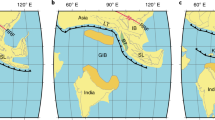Abstract
BECAUSE of their role in testing the crustal spreading hypothesis1 the ages of Atlantic islands have assumed a prime importance2. Conventional geological methods are not usually applicable to studies of oceanic islands, because of the general lack of stratigraphically useful fossils and the dominantly volcanic environment. Palaeomagnetic methods, as pioneered by Einarsson3, however, can provide valuable stratigraphic indices in volcanic regions. In addition, if defined from a time span sufficient to average out secular variation4, palaeomagnetic poles can provide age estimates, because with increasing age they have occupied positions at increasing angular distances from the present geographic pole. Palaeomagnetic surveys are forming the bases of diverse studies of Atlantic islands. This is the third in a series of reports5,6, in which the palaeomagnetic poles resulting from these surveys are reported.
Similar content being viewed by others
References
Hess, H. H., Geol. Soc. Amer., Buddington volume, 599 (1962).
Wilson, J. T., Nature, 198, 925 (1963).
Einarsson, T., Adv. Phys., 6, 238 (1957).
Cox, A., and Doell, R. R., Bull. Seis. Soc. Amer., 54, 2243 (1964).
Watkins, N. D., Richardson, A., and Mason, R. G., Earth Planet. Sci. Lett., 1, 225 (1966).
Watkins, N. D., Richardson, A., and Mason, R. G., Earth. Planet. Sci. Lett., 1, 471 (1966).
Almeida, F. F. M., in Monog. XIII, Div. Geol. e Min., Dep. Nac. Prod. Min. Minist. Agril., Serv. Graf. Inst. Brasil de Geog. Estat. Rio de Janeiro (1958).
Branner, J. C., Amer. J. Sci., 37, 152 (1889).
Almeida, F. F. M., ref. 7, page 177.
Wilson, J. T., Phil. Trans. Roy. Soc., 258, 156 (1965).
Vincenz, S. A., and Bruckshaw, J. McG., Proc. Camb. Phil. Soc., 56, 21 (1960).
Fisher, R. A., Proc. Roy. Soc., 217, 295 (1953).
Runcorn, S. K., Ann. Geophys., 15, 87 (1959).
Doell, R. R., and Cox, A., Adv. Geophys., 8, 294 (1961).
Irving, E., in Palaeomagnetism and its Applications to Geological and Geophysical Problems, 124 (John Wiley and Sons, New York, 1964).
Author information
Authors and Affiliations
Rights and permissions
About this article
Cite this article
RICHARDSON, A., WATKINS, N. Palaeomagnetism of Atlantic Islands: Fernando Noroñha. Nature 215, 1470–1473 (1967). https://doi.org/10.1038/2151470a0
Received:
Issue Date:
DOI: https://doi.org/10.1038/2151470a0
- Springer Nature Limited
This article is cited by
-
Preliminary Palaeomagnetic Study of Igneous Rocks from Abrolhos Islands, Brazil
Nature Physical Science (1972)





